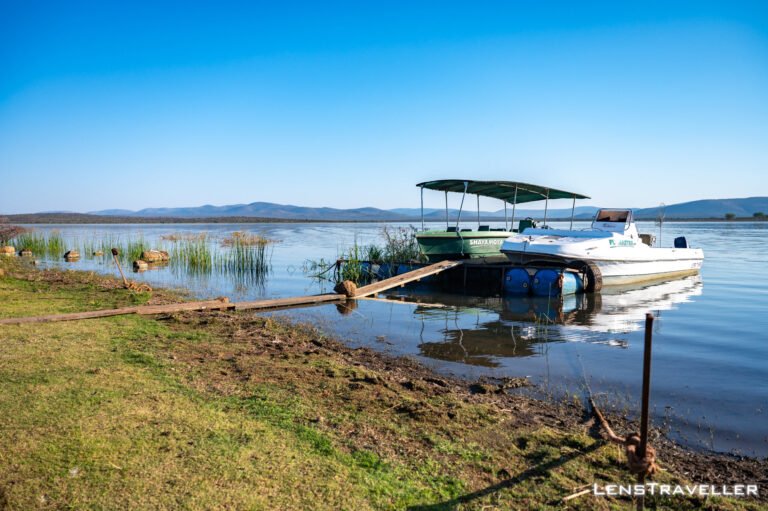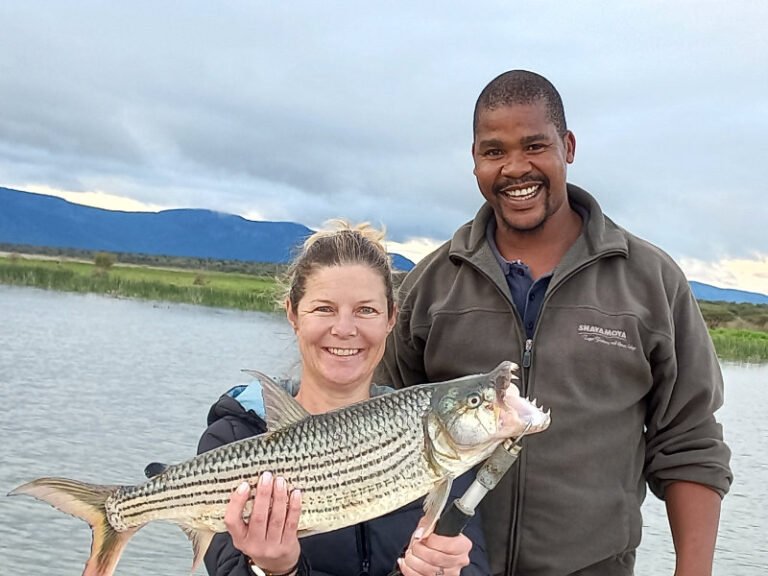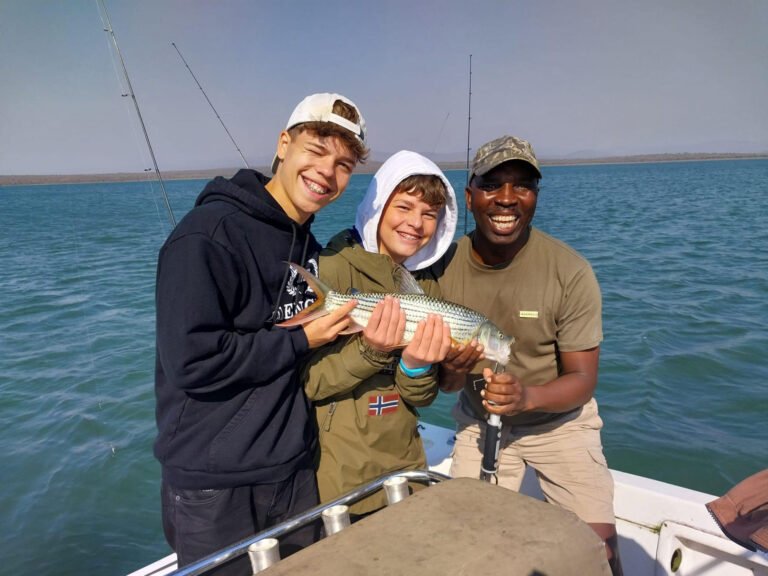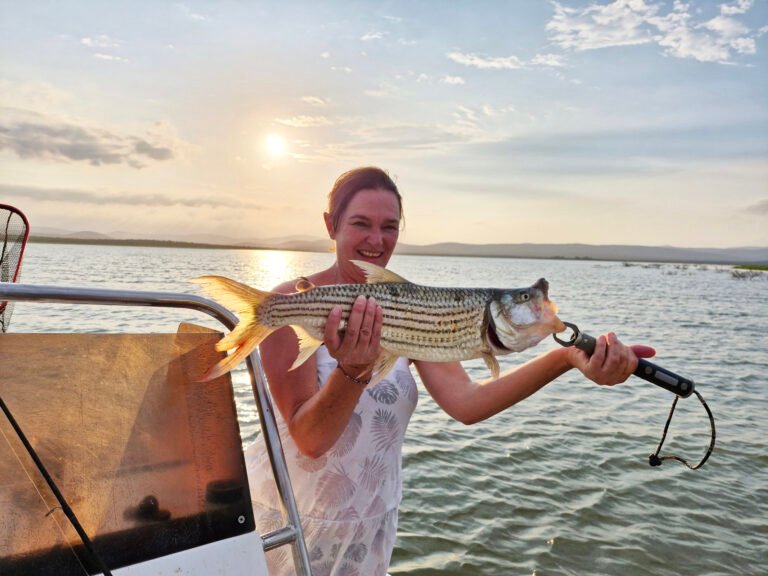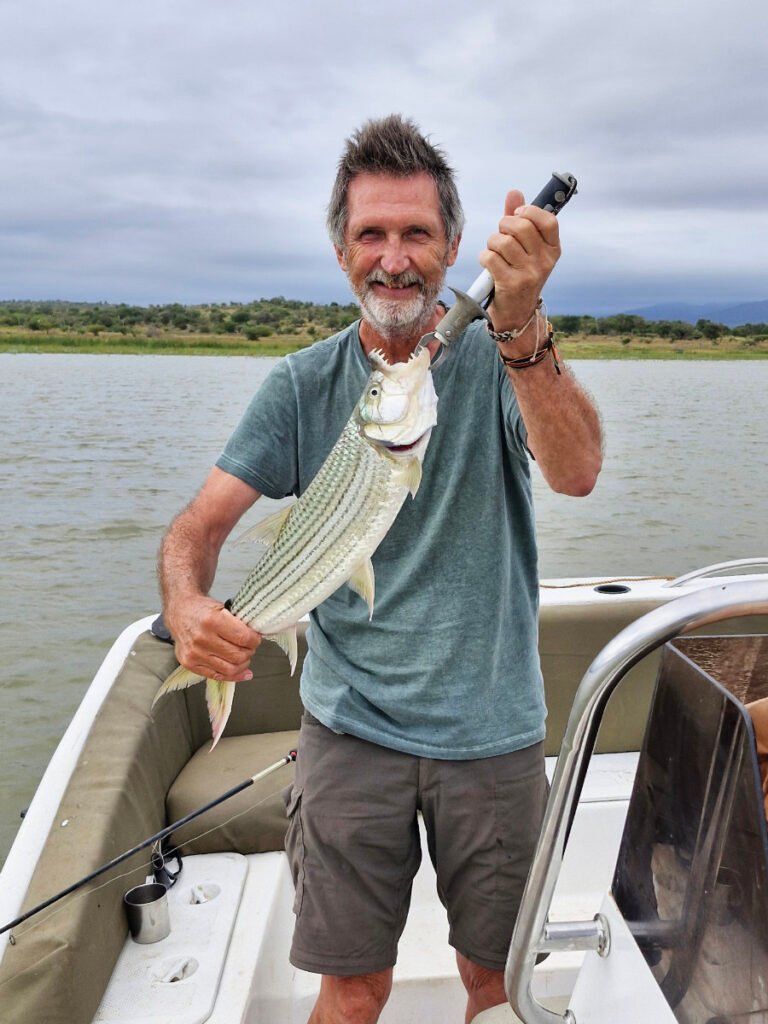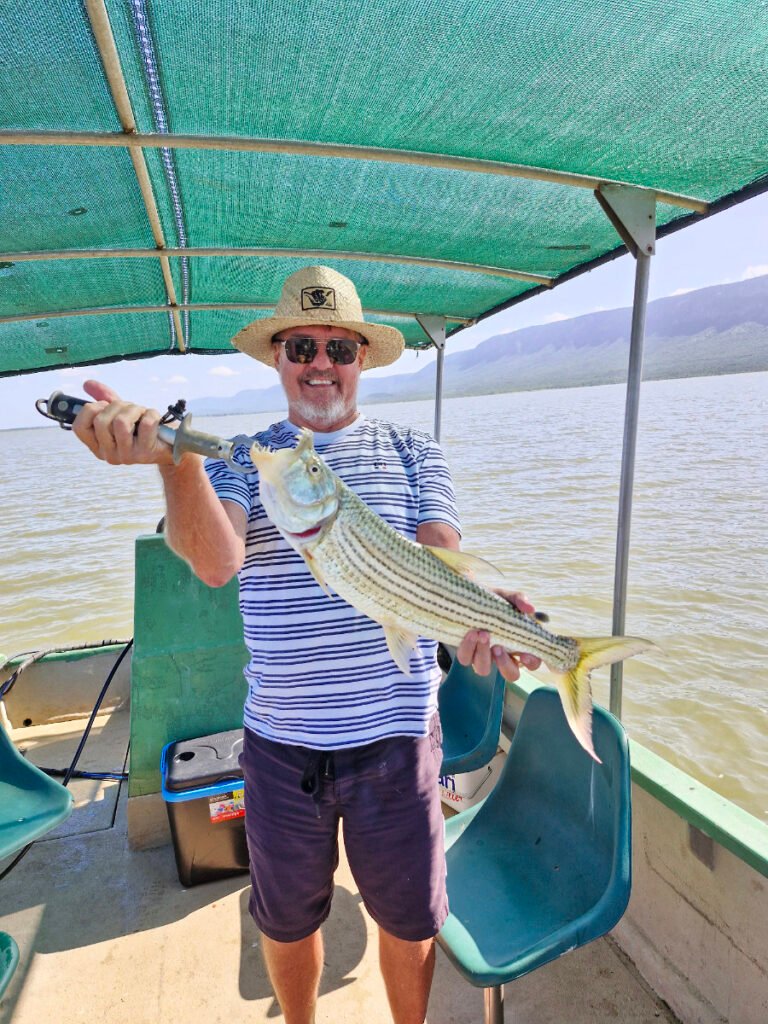Tiger Fishing
Shayamoya’s Specialty!
Tiger fishing is a truly exhilarating activity that we offer. This species of ferocious fighting game fish is rare in South African waters. Lake Jozini, also known as Pongolapoort, spans 17,000 hectares and is the only lake in South Africa home to tiger fish, scientifically known as Hydrocynus vittatus, commonly referred to as the “striped water dog.”
Impressive sizes have been caught in Lake Jozini, with the official record being 8.3 kg.
The tiger fishing season runs from August to early November and March to May, although we fish year-round. The lodge has a selection of fishing rods and tackle available for hire.
The rates include boat hire, guide and one tank of fuel
- 21 ft Flymaster, Max 6 fishermen, Min 2, not exclusive
- Half Day Minimum: R1865 or R750 per person, R615 p/child
- Rod hire: R150 per rod (Lost or damaged tackle to be replaced)
- Bait: Sardines @ R100 per kg
Summertime is regarded as September to April.
Winter time is regarded as May to August.
The Parksboard officials have instituted the policy that all fishing above the Railway Bridge is prohibited to protect the breeding sanctuary and all tiger fish
caught are “Catch and Release” to protect the species.
Tiger Fishing Terms & Conditions
Bookings and Confirmations
- Tiger fishing trips which are booked in advance require a full prepayment as confirmation.
Cancellation
- Please note last minute cancellations will not be refunded and you are liable for the number of anglers pre booked.
Refunds
- If weather conditions do not permit us to go fishing, we can either re-schedule. If this is not possible Shayamoya will issue a refund.
Departure Times
- We only operate during our scheduled departure hours unless alternative arrangements have been discussed.
- We travel via open Landcruiser from the Lodge through the Phongolo Nature Reserve to the Shayamoya jetty which is a 10km route.
- Departing the Lodge at 5:30am or 2pm in Summer and 8am in Winter.
- Rods up at 10am, 12am or 6pm to allow for the return transfer to the Lodge.
Alcohol Beverages
- It is law that alcohol is not permitted to be consumed on the boats.
Captain Has The Final Say
- The skipper is responsible for your lives, and he has the final say in any situation.
The Pongolapoort Lake
Also known as Jozini, is situated in the Northeastern KwaZulu Natal, bordering Southern Swaziland. It is the southernmost extremity of the infamous Tiger Fish population (Hyrocynus Vittatus) due to our hot Summer temperatures and moderate Winter climate, and it is the only waters in South Africa home to the tiger fish. The lake covers +/- 16000 hectares, with a river stretch of approximately 5km. It is set against the backdrop of the Lebombo Mountain range, giving the eastern shores deep basaltic drop offs ideal for tiger fish. The ’Poort’ or Gorge, is a 7km stretch leading to the dam wall, with crystal clear waters of 60 meters deep and overhanging cycads. The western shores are mainly mud flats with the odd underwater islands ideal for breeding baitfish including two species of Tilapia, catfish, carp, mudfish and a large variety of smaller fish. The Phongolo River feeds the lake and this stretch is made up of both of the above conditions, with old submerged trees making up most of the tiger fish hideouts. The Northern tip stretches into Swaziland itself however we are not permitted to fish here. The other area fishing is prohibited, is from the railway bridge upstream which is a breeding sanctuary area. Fishing takes place from boats as the shoreline is crowded with semi-submerged trees and not to mention the large population of hippos and crocodiles on the water.
The tiger or striped water dog occurs in all rivers flowing eastwards in most of Africa, so they have occurred here naturally for centuries. Their cousin is the Goliath tiger, which grow up to 50kg’s in the Congo. Our record specimen was caught in 1998 weighing 8,3kg and some in the 5-7kg ranges are still being caught. Average size is around a kilo and specimens up to 4kg are quite possible in a 3 day fishing tour.
One never tires trying to tackle the tiger, be it the hard bony jaws, big teeth, sheer cunningness, or remote areas. Their fantastic skill to bite through a lure/bait is what makes them such an exciting fish to catch. An average of 4:1 is expected when fishing for tigers. They attack from the side, then turn their bait around and swallow it headfirst. Tigers have been recorded to hit their prey at 50km/hr! They have 20 conical teeth that are extremely sharp and covered with an antico-agulant. Whole sets of teeth are continually replaced during their lifetime. On average, they gain one kg a year and the life span is about 8 years. Tigerfish occur in schools and are cannibalistic. The juveniles stay close to any structures in their first year where they can take cover. They are pelagic which means feeding and living in the top reaches of the water and going down to deeper water when light intensity increases and in the evening. This allows them to take cover from any predators during the warmer parts of the day and then again feeding in the late afternoon.
They are ferocious feeders, competing for food continually. Their diet is made up many species of fish, sardines, chicken livers, squid they eat just about anything. They are fast learners and vary their diet considerably. Tigers inhabit waters close to the side of the lake or around suitable structures. They are not generally open water feeders and we target them in depths from 4m to 10 meters. Depending on the season, water temperatures and available food, depths vary, but it is not uncommon to find them in 30 meters of water.
Conventional Tackle
Rods
- Any firm 6 foot stick (10 to 20 lb) will do for the tiger, finding most bass sticks appropriate. A lighter flick stick for spinning smaller rapalas and spinners is also a must.
Reels
- Here a good reel is important to handle short fast hard runs; a good drag system. Good coffee grinders or bait casters that can hold +/- 120m of line is imperative.
Line
- High abrasive line is a must as most of the fishing or fish land up dashing for structure where they are able to hang you up.
- A good 12 – 15 lb breaking strain is sufficient. ‘Fireline’, a very strong light line allows for good accuracy and strength.
Hooks
- Chemically sharpened hooks allow for better penetration, and we believe good line and hooks is the key to successful tiger fishing.
- Any size from a 1/0 to 6/0 are most commonly used e.g. Mustad, Daichi, Kamakatsu.
Artificials
- A variety of spinners, spoons, rapalas and spinner baits should make up your tackle box.
- Red, silver and bronze spinners and spoons work best, ranging from 4g - 12g.
- The rapala range is up to your own discretion due to their price. Red and white and natural colours tend to be the best.
- A suggestion would be changing most of the above to single hooks as it allows better penetration and does not damage the fish as much as treble hooks.
- A suggestion would be changing most of the above to single hooks as it allows better penetration and does not damage the fish as much as treble hooks.
3 Tips
- The brighter the sun the brighter the lure; use shallow to medium depth lures for early morning or late afternoon fishing.
- When spinning, start off with a fast retrieve. If this doesn’t work, allow the lure to drop a bit deeper and try the same retrieve, then slow the retrieve down. If they still don’t take, upsize or downsize the lure, and last of all change the lure.
- But don’t over-fish an area, rather come back later as tiger fish are easily spooked off by too much presence.
Live Bait
- If you can source small Tilapia, 5-12cm in size, fished with a float or free swimming.
- The free swimming live bait have always been effective. Run the hook through the skin close to the dorsal fin, cast gently, don’t retrieve too often, set a loose drag, and allow the tiger fish to hit it and swallow it before striking.
Other Bait
- At Shayamoya we fish with Sardines which are very effective and rigged up the same way as you would use them for the saltwater fishing.
- The more blood the better, so use half a sardine. Fished with a sinker, on or without a drift. Ensure the hook is concealed yet the point is out.
Two important tips when tiger fishing: When to strike – free spooling is the most common tactic, but there are takes when you have to strike right away, set the hook once and allow the fish to have some drag. Keep the rod tips down – The whole fight, the rod tip should be down. The tiger gives you about 3 seconds before his first jump when he will take advantage of the slack in your line, so automatically drop the tip.
Therefore once the bait has been picked up by a fish you should allow it sufficient time to eat the bait properly while the reel is giving line freely. Once you decide that the bait has been swallowed, then tighten up and only give a couple of firm nods to the rod once the line is properly tight and the fish is pulling hard on the other end. Simple!
By using circle hooks you will seldom gut hook, or throat hook fish, and the chances of your fish surviving the experience is so much better than using any other method of bait fishing. Also, because the hook will not set in the guts, you can allow it to feed a bit longer before deciding to set the hook without concern that it is going to be hooked to deep. This cuts out some of the anxiety of striking too soon which can happen when fishing with conventional J-hooks and not wanting to kill the fish.
Other Equipment
Polaroid sunglasses, light weight shirts and long trousers, a wide brim hat and sun block Factor 30+ Tigers are predatory fish preferring warm clear waters, aiding their hunting and feeding instincts.
When to Catch Tiger Fish
Firstly September through to November is their spawning months, and like many other fish species, they tend to spawn in fast flowing waters up stream. They are stimulated to breed when temperatures go over 20 degrees and this coincides with our rains. This is an ideal time to try and tackle the bigger spawning females on their way up to their breeding sanctuaries.
December to February is when the weather is at its hottest in the area, and although fishing is still excellent, fishing days consists of short sessions being early morning and late afternoon.
From March to May tigers are generally fattening up for the winter months and also a good time of the year to seek them out.
June to August also produces fish although it all depends on the climate, as a drop in temperature can put them off the bite for a couple of days.
Other Species
Certainly the Pongolapoort Lake has a greater variety of species than any other body of fresh water in the country. It is not only because floods released exotic species such as black bass and carp into the lake but also because the lake sub- tropical positioning thus home to species normally found only in Central Africa. Aswell as tiger, there are blue kurper (Oreochromis mossambicus), red-breasted kurper (Tilapia rendalli), huge catfish, yellowfish, red-nosed mudfish, silver and butter barbell, a dozen species of barbs and minnows including the silver robber or dwarf tigerfish (Micralested acutidens). Even tiny freshwater gobies are present which have adapted from marine lifestyle.
Competitions
There is 1 national tiger fishing competition annually. The major Sodwana Bay Angling Club’s competition takes place the long weekend in September, attracts up to 300 boats with the prizes getting bigger and bigger each year.
Frequently Asked Questions
What month is best for Tiger Fishing?
You can catch tigerfish throughout the year, however as the seasons transition to March through May, the tigerfish are busy bulking up for the upcoming winter months. It’s a prime time of the year to track them down and test your angling skills. Additionally, from June to August, there are still opportunities but they do slow down in cooler temperatures. Then from September/October it becomes busy again as temperatures rise and spawning begins.
Why is the African Tigerfish so exciting to catch?
It’s actually pretty simple: They’re underwater bullets with armored scales and a mouth full of razor-sharp daggers. Oh, and they’re also really fun to catch. Tigerfish can dent lures, bite through leaders, and empty spools at an incredible pace. On top of all that, they’re unpredictable – spooky one minute, headstrong and aggressive the next. Throw in some aerial acrobatics and seriously good looks, and you’ve got a fish you could spend your whole life catching.
Is there is a launch site if I bring my own boat?
Yes, at the Phongolo Nature Reserve 10km away.
Can you eat Tigerfish?
How do you hold a Tigerfish?
Hold the fish horizontally, take the pic quickly and release the fish. Do not use a Boga Grip to hold the fish while taking the pic. This is ugly and harms the fish. Use the Bog Grip to stabilize the fish while you take out the hook only.


